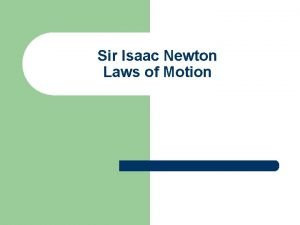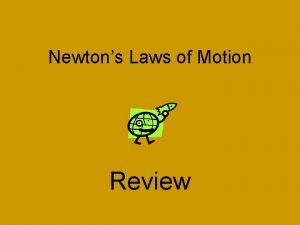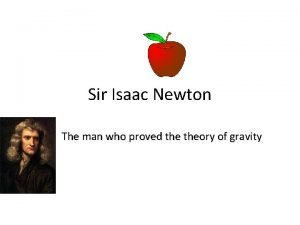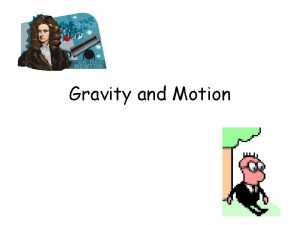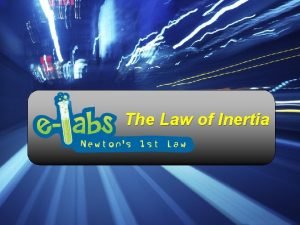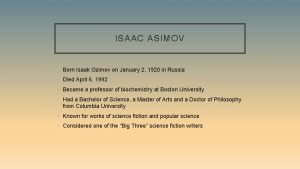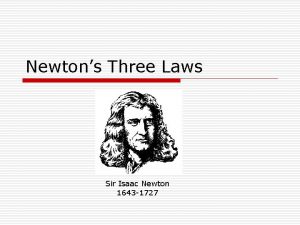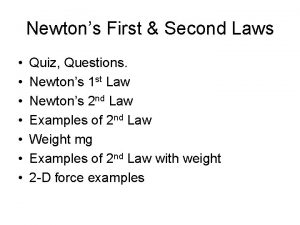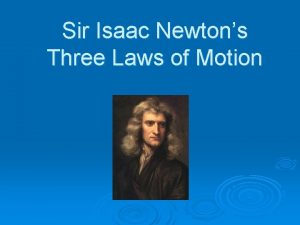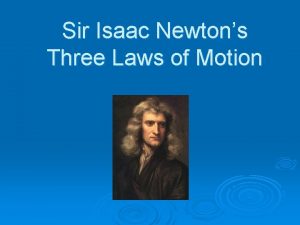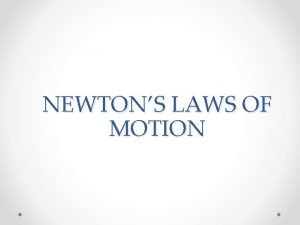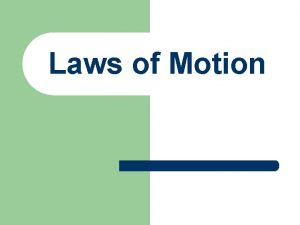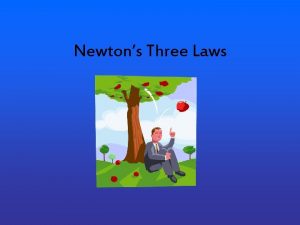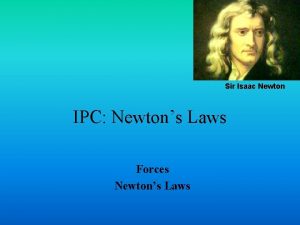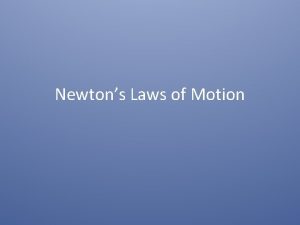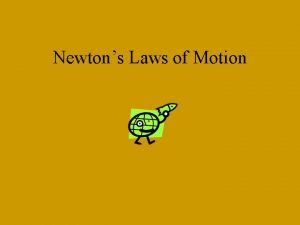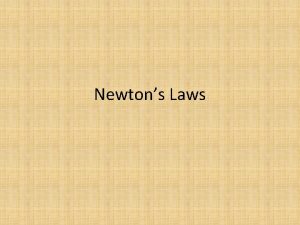Newtons Laws of Motion Who was Sir Isaac













- Slides: 13

Newton’s Laws of Motion

Who was Sir Isaac Newton? ● ● ● ● Born in England, Isaac Newton was a highly influential physicist, astronomer, mathematician, philosopher, alchemist and theologian. In 1687, Newton published Philosophae Naturalis Principia Mathematica, what is widely regarded to be one of the important books in the history of science. In it he describes universal gravitation and the three laws of motion, concepts that remained at the forefront of science for centuries after. Newton’s law of universal gravitation describes the gravitational attraction between bodies with mass, the earth and moon for example. Newton’s three laws of motion relate the forces acting on a body to its motion. The first is the law of inertia, it states that ‘every object in motion will stay in motion until acted upon by an outside force’. The second is commonly stated as ‘force equals mass times acceleration’, or F = ma. The third and final law is commonly known as ‘to every action there is an equal and opposite reaction’. Other significant work by Newton includes the principles of conservation related to momentum and angular momentum, the refraction of light, an empirical law of cooling, the building of the first practical telescope and much more. Newton moved to London in 1696 and took up a role as the Warden of the Royal Mint, overseeing the production of the Pound Sterling. Newton was known to have said that his work on formulating a theory of gravitation was inspired by watching an apple fall from a tree. A story well publicized to this very day. "If I have seen further it is only by standing on the shoulders of Giants. " Newton

Motion • Motion is an object’s change in position • Example: A ball goes through motion when it is thrown from one place to another

Velocity • • Velocity is the speed and direction an object is moving Velocity changes if the object stays the same speed but changes direction (for example: an object moving in a circle)

Acceleration • • Acceleration is the rate of change of an object’s velocity When an object’s velocity changes, its acceleration also changes • • Positive acceleration, negative acceleration a= (Vf-Vi) • (tf-ti)

Inertia • • Inertia is the tendency for an object to resist any change in motion Inertia is related to an object’s mass: • • Example: it is easier to change the direction of a ping pong ball than a bowling ball The greater the mass of an object, the greater the inertia • Example: the bowling ball has greater inertia than the ping pong ball

momentum In Newtonian mechanics, linear momentum, translational momentum, or simply momentum is the product of the mass and velocity of an object. It is a vector quantity, possessing a magnitude and a direction in three-dimensional space. p = mv p is momentum m is mass v is velocity

Newton’s 1 st Law of Motion • Newton’s 1 st Law of Motion (also called the Law of Inertia) states that: • • an object moving at constant velocity keeps moving at that velocity unless a force acts on it an object at rest stays at rest until a force acts on it

Newton’s 1 st Law of Motion • Real Life Application? • Cup of coffee in the car • Seatbelt in a car • Head rest in a car

Newton’s 2 nd Law of Motion • • Newton’s 2 nd Law of Motion states that a force of an object is equal to the mass of the object multiplied by the object’s acceleration F = ma (where F is force, m is mass, and a is acceleration)

Newton’s 2 nd Law of Motion • Real Life Application? • Big cars vs. small cars

Newton’s 3 rd Law of Motion • • Newton’s 3 rd Law of Motion states that when one object exerts a force on a second object, the second object exerts a force back on the first object that is equal in size and opposite in direction Another way to say this is that for every action, there is an equal and opposite reaction

Newton’s 3 rd Law of Motion • Real Life Application? • Skateboards • Rockets • Tug of War




